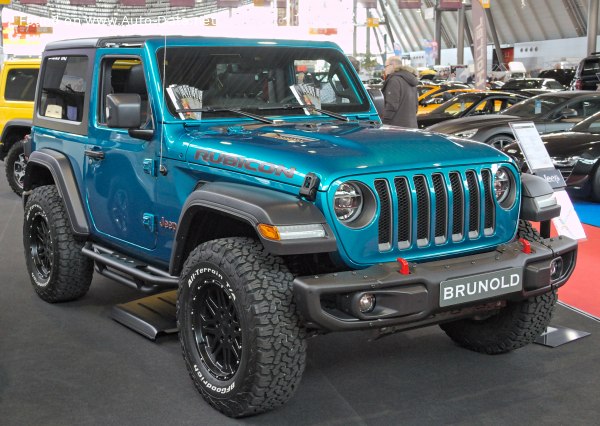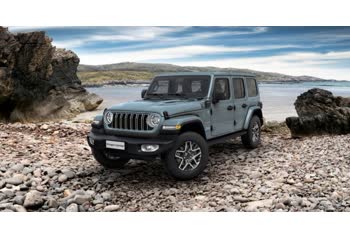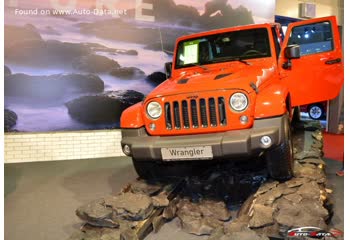Everything you need to know about specifications and performance - Jeep Wrangler 2017 - Sport 2.0 Turbo (270 Hp) eTorque Mild Hybrid 4x4 Automatic

Overview:
What is the engine capacity of a Jeep Wrangler 2017?
The engine capacity of the Jeep Wrangler 2017 is 1995.
Jeep Wrangler 2017 How many horsepower?
The engine power of the Jeep Wrangler 2017 is 270 Hp @ 5250 rpm..
What is the Jeep Wrangler 2017 engine?
Jeep Wrangler 2017 engine is Hurricane / EC3. (Click to see other cars using the same engine)
How much gasoline does a Jeep Wrangler 2017 consume?
The Jeep Wrangler 2017 consumes 9.8 liters of gasoline per 100 km
General:
Brand: Jeep
Model: Wrangler
Generation: Wrangler IV (JL)
Modification (Engine): Sport 2.0 Turbo (270 Hp) eTorque Mild Hybrid 4x4 Automatic
Start of production: November, 2017
End of production: August, 2019
Powertrain Architecture: MHEV (Mild Hybrid Electric Vehicle, power-assist hybrid, battery-assisted hybrid vehicles, BAHV)
Body type: Off-road vehicle
Seats: 4
Doors: 2
Engine:
Engine systems: Start & Stop System
Power: 270 hp @ 5250 rpm.
Power per litre: 135.3 hp/l
Torque: 400 nm @ 3000 rpm.
Engine Model/Code: Hurricane / EC3
Engine displacement: 1995
Number of cylinders: 4
Engine configuration: Inline
Number of valves per cylinder: 4
Fuel injection system: Direct injection
Engine aspiration: Twin-scroll turbo, Intercooler
Valvetrain: DOHC
Engine oil capacity: 4.73 l
Coolant: 9.4 l
Engine layout: Front, Longitudinal
Cylinder Bore: 84 mm
Piston Stroke: 90 mm
Compression ratio: 10:1
Maximum engine speed: 5800 rpm.
Performance:
Fuel Type: Petrol (Gasoline)
Fuel consumption (economy) - urban: 10.2 l/100 km
Fuel consumption (economy) - extra urban: 9.4 l/100 km
Fuel consumption (economy) - urban (EPA): 10.2 l/100 km
Fuel consumption (economy) - extra urban (EPA): 9.4 l/100 km
Fuel consumption (economy) - combined (EPA): 9.8 l/100 km
Fuel consumption (economy) - combined: 9.8 l/100 km
Weight-to-power ratio: 6.7 kg/Hp, 148.4 Hp/tonne
Weight-to-torque ratio: 4.5 kg/Nm, 219.9 Nm/tonne
Electric system:
Gross battery capacity: 0.43 kWh
Battery technology: Lithium-ion (Li-Ion)
Electric motor location: Front, Longitudinal
Battery voltage: 48 V
Space:
Kerb Weight (kg): 1819
Trunk (boot) space - maximum: 508 l
Trunk (boot) space - minimum: 203 l
Permitted trailer load with brakes (12%): 907 kg
Fuel tank capacity: 70 l
dimensions:
Ramp-over (brakeover) angle: 25°
Length: 4237 mm
Width: 1875 mm
Height: 1868 mm
wheelbase: 2460 mm
Front track: 1598 mm
Rear (Back) track: 1598 mm
Front overhang: 742 mm
Rear overhang: 1036 mm
Ride height (ground clearance): 246 mm
Minimum turning circle (turning diameter): 10.5 m
Approach angle: 41.4°
Departure angle: 35.9°
Powertrain, Suspension and Brakes:
Drivetrain Architecture: The Internal combustion Engine (ICE) and the electric motor permanently drive the rear wheels of the vehicle, capable of running only in mixed mode, and if necessary through the electrically or mechanically controlled clutch, the front wheels are driven.
Drive wheel: All wheel drive (4x4)
Number of gears and type of gearbox: 8 gears, automatic transmission
Front brakes: Ventilated discs, 330x24 mm
Rear brakes: Disc, 342x14 mm
Assisting systems: ABS (Anti-lock braking system)
Steering type: Cone worm with recirculation balls
Power steering: Electric Steering
Tires size: 245/75 R17
Wheel rims size: 7.5J x 17
Front suspension: Coil spring, Rigid axle suspension, Transverse stabilizer
Rear suspension: Rigid axle suspension, Transverse stabilizer, Coil Spring
See also

2023 Jeep Wrangler IV Unlimited (JL, facelift 2023) Rubicon 2.0L (380 Hp) 4xe Plug-in Hybrid 4x4 Automatic
Last generation.
Its production began in 2023 until Now

Other generation.
Its production began in 2007 until 2009

Write a comment